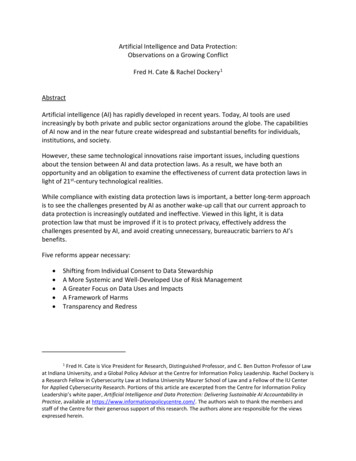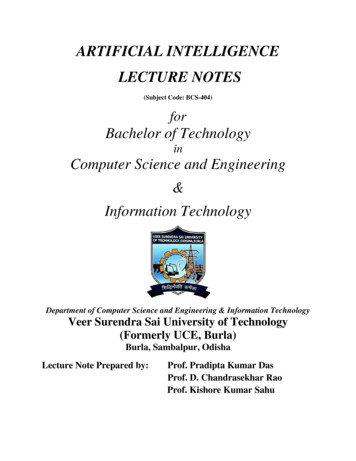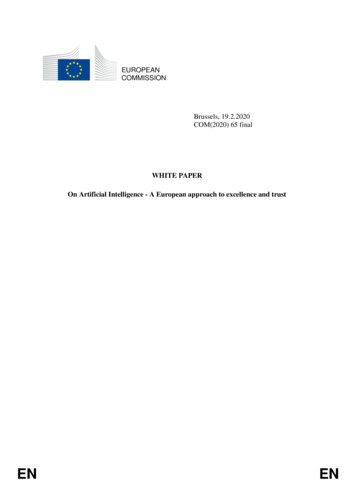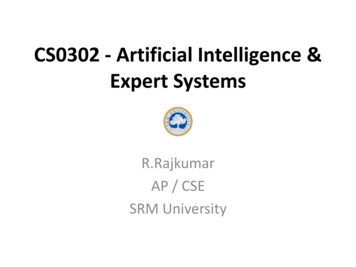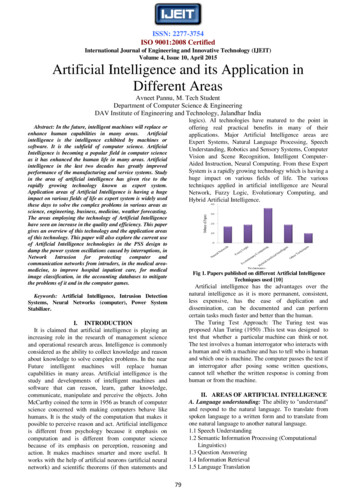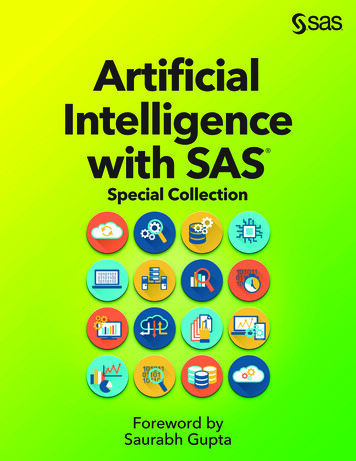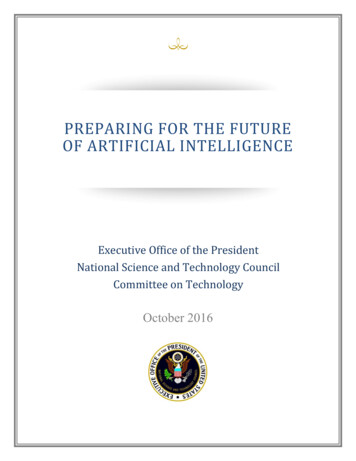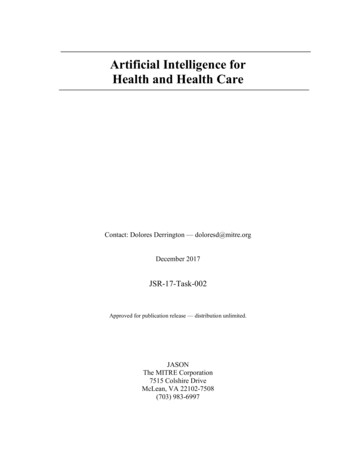
Transcription
Artificial Intelligence forHealth and Health CareContact: Dolores Derrington — doloresd@mitre.orgDecember 2017JSR-17-Task-002Approved for publication release — distribution unlimited.JASONThe MITRE Corporation7515 Colshire DriveMcLean, VA 22102-7508(703) 983-6997
1
ContentsEXECUTIVE SUMMARY11.1 Why Now? .81.2 JASON Study Charge and Process .92 AI IN HEALTH DIAGNOSTICS: OPPORTUNITIES ANDISSUES FOR CLINICAL PRACTICE112.1 Advance in AI Applications for Medical Imaging .112.1.1 Detection of diabetic retinopathy in retinal fundus images . 112.1.2 Dermatological classification of skin cancer.132.1.3 Data issues .142.2 Moving Computational Advances into Clinical Practice .152.2.1 Coronary artery disease –issues driving interest in improved methods .152.2.2 Development of new approaches – non-invasive diagnostics .152.2.3 Development and validation for clinical applications .162.2.4 Summary points for developing clinical applications .182.3 Evolution of Standards for AI in Medical Applications .183 PROLIFERATIONS OF DEVICES AND APPS FOR DATACOLLECTION AND ANALYSIS213.1 Personal Networked Devices and Apps .213.1.1 Capturing mobile device information – utility and privacy .233.1.2 Online plus AI .233.1.3 Examples of privacy and transparency .243.2 Concerns about “Snake Oil”.253.3 Concerns about Inequity.264 ADVANCING AI ALGORITHM DEVELOPMENT294.1 Crowdsourcing .294.1.1 Crowdsourcing competitions .304.1.2 Citizen science .314.2 Deep Learning with Unlabeled Data .32iii
5 LARGE SCALE HEALTH DATA356 ISSUES FOR SUCCESS435.1 Current Efforts – All of Us Research Program .365.2 Environment Data – The Missing Data Stream.405.2.1 Capturing data on toxin exposure . 405.2.2 Environmental sensing at different geographic resolutions .416.1 Plans for use of Legacy Health Records .436.2 Evaluation .477 FINDINGS AND RECOMMENDATIONS498 EPILOGUE53APPENDIX: Statement of Work55REFERENCES57iv
EXECUTIVE SUMMARYThis study centers on how computer-based decision procedures, under the broad umbrella ofartificial intelligence (AI), can assist in improving health and health care. Although advancedstatistics and machine learning provide the foundation for AI, there are currently revolutionaryadvances underway in the sub-field of neural networks. This has created tremendous excitementin many fields of science, including in medicine and public health. First demonstrations havealready emerged showing that deep neural networks can perform as well as the best humanclinicians in well-defined diagnostic tasks. In addition, AI-based tools are already appearing inhealth-oriented apps that can be employed on handheld, networked devices such as smartphones.Focus of the Study.U.S. Department of Health and Human Services (HHS), with support from the Robert WoodJohnson Foundation, asked JASON to consider how AI will shape the future of public health,community health, and health care delivery. We focused on technical capabilities, limitations,and applications that can be realized within the next ten years.Some questions raised by this study are: Is the recent level of interest in AI just another period ofhype within the cycles of excitement that have arisen around AI? Or would differentcircumstances this time make people more receptive to embracing the promise of AIapplications, particularly related to health? AI is primarily exciting to computational sciencesresearchers throughout academia and industry. Perhaps, the previous advances in AI had noobvious influence on the lives of individuals. The potential influence of AI for health, includinghealth care delivery, may be affected by current societal factors that may make the fate of AIhype different this time. Currently, there is great frustration with the cost and quality of caredelivered by the US health care system. To some degree, this has fundamentally eroded patientconfidence, opening people’s minds to new paradigms, tools, services. Dovetailing with this,there is an explosion in new personal health monitoring technology through smart deviceplatforms and internet-based interactions. This seemingly perfect storm leads to an overarchingobservation, which defines the environment in which AI applications are now being developedand has helped shape this study:Overarching Observation: Unlike previous eras of excitement over AI, the potential of AIapplications in health may make this era different because the confluence of the following threeforces has primed our society to embrace new health centric approaches that may be enabled byadvances in AI: 1) frustration with the legacy medical system, 2) ubiquity of networked smartdevices in our society, 3) acclimation to convenience and at-home services like those providedthrough Amazon and others.Findings and Recommendations:Overall, JASON finds that AI is beginning to play a growing role in transformative changes nowunderway in both health and health care, in and out of the clinical setting. At present the extentof the opportunities and limitations is just being explored. However, there are significant1
challenges in this field that include: the acceptance of AI applications in clinical practice,initially to support diagnostics; the ability to leverage the confluence of personal networkeddevices and AI tools; the availability of quality training data from which to build and maintainAI applications in health; executing large-scale data collection to include missing data streams;in building on the success in other domains, creating relevant AI competitions; andunderstanding the limitations of AI methods in health and health care applications.Here we provide the JASON findings and recommendations. Discussion and elaboration on eachof these is presented in the text.1. AI Applications in Clinical PracticeFindings: The process of developing a new technique as an established standard of care uses therobust practice of peer-reviewed R&D, and can provide safeguards against thedeceptive or poorly-validated use of AI algorithms. (Section 2.3) The use of AI diagnostics as replacements for established steps in medical standardsof care will require far more validation than the use of such diagnostics to providesupporting information that aids in decisions. (Section 2.3)Recommendations: Support work to prepare AI results for the rigorous approval procedures needed foracceptance for clinical practice. Create testing and validation approaches for AIalgorithms to evaluate performance of the algorithms under conditions that differfrom the training set. (Section 2.3)2. Confluence of AI and Smart Devices for Monitoring Health and DiseaseFindings: Revolutionary changes in health and health care are already beginning in the use ofsmart devices to monitor individual health. Many of these developments are takingplace outside of traditional diagnostic and clinical settings. (Section 3.1) In the future, AI and smart devices will become increasingly interdependent,including in health-related fields. On one hand, AI will be used to power manyhealth-related mobile monitoring devices and apps. On the other hand, mobile deviceswill create massive datasets that, in theory, could open new possibilities in thedevelopment of AI-based health and health care tools. (Section 3.1)Recommendations: Support the development of AI applications that can enhance the performance of newmobile monitoring devices and apps. (Section 3.1) Develop data infrastructure to capture and integrate data generated from smartdevices to support AI applications. (Section 3.1) Require that development include approaches to insure privacy and transparency ofdata use. (Section 3.1) Track developments in foreign health care systems, looking for useful technologiesand also technology failures. (Section 3.1)2
3. Create Comprehensive Training Databases of Health Data for AI Tool DevelopmentFindings: The availability of and access to high quality data are critical in the development andultimate implementation of AI applications in health care. (Section 4) AI algorithms based on high quality training sets have already demonstratedperformance for medical image analysis at the level of the medical capabilitythat is captured in their training data. (Section 2.1) AI algorithms cannot be expected to perform at a higher level than theirtraining data, but should deliver the same standard of performanceconsistently for data within the training space. (Section 2.1) Laudable goals for AI tools include accelerating the discovery of novel diseasecorrelations and helping match people to the best treatments based on their specifichealth, life-experiences, and genetic profile. Definition and integration of the datasets required to develop such AI tools is a major challenge. (Section 4) Extreme care is needed in using electronic health records (EHRs) as training sets forAI, where outputs may be useless or misleading if the training sets contain incorrectinformation or information with unexpected internal correlations. (Section 6.1) Techniques for learning from unlabeled data could be helpful in addressing the issueswith using data from a diverse set of sources. (Section 4.2)Recommendations: Support the development of and access to research databases of labeled and unlabeledhealth data for the development of AI applications in health. (Section 4) Support investigations into how to incentivize the sharing of health data, and newparadigms for data ownership. (Section 4) Support the assessment of AI algorithms trained with data labeled at levels thatsignificantly exceed standard assessment, for instance the use of outputs from thenext stage of diagnostics (e.g., use of biopsy results to label dermatological images).(Section 2.1) Support research to characterize the tradeoffs between data quality, informationcontent (complexity and diversity) and sample size, with the goal of enablingquantitative prediction of the quantity and quality of data needed to support a givenAI application. (Section 4) Identify and develop strategies to fill important data gaps for health. (Section 4) Develop automated curation approaches for broadly based data collections to formatthem for AI tools, e.g., as with well labeled imagery. (Section 4.2)4. Fill in Critical Missing Data GapsFindings: AI application development requires training data, and will perform poorly whensignificant data streams are absent. While DNA is the blueprint for life, healthoutcomes are highly affected by environmental exposures and social behaviors. Thereis an imbalance in the effort to capture the diverse data needed for application of AI3
techniques to precision medicine, with information on environmental toxicology andexposure particularly suffering: (Section 5.2.2) Techniques exist to capture individual environmental exposures, e.g., bloodtoxin screening, diet questionnaires. Techniques exist for environmental pathogen sensing. Technologies exist that can capture environmental exposures geographicallyand create environment tracking systems.Recommendations: Support ambitious and creative collection of environmental exposure data: (Section5.2.2) Build toxin screening (e.g., dioxin, lead) into routine blood panels, andquestions about diet and environmental toxins into health questionnaires. Start urban sensing and tracking programs that align with the geographic areasfor the All of Us Research Program and similar projects in the future. Support the development of wearable devices for the sensing of environmentaltoxins. Support the development of broad-based pathogen sensing for rural and urbanenvironments. Develop protocols and IT capabilities to collect and integrate the diverse data.5. Embrace the Crowdsourcing Movement to Support AI development and Data GenerationFinding: AI competitions have already demonstrated their value in 1) encouraging thecreation of large corpuses of data for broad use, and 2) demonstrating the capabilities of AIin health, when provided data that are curated into a well labeled (namely high informationcontent) format. (Section 4.12)Recommendations: Support competitions created to advance our understanding of the nature of healthand health care data. (Section 4.12) Share data in public forums to engage scientists in finding new discoveries that willbenefit health. (Section 4.12)6. Understand the Limitations of AI Methods in Health and Health care ApplicationsFindings: There is potential for the proliferation of misinformation that could cause harm orimpede the adoption of AI applications for health. Websites, Apps, and companieshave already emerged that appear questionable based on information available.(Section 3.2) Methods to insure transparency in disclosure of large scale computational models andmethods in the context of scholarly reproducibility are just beginning to be developedin the scientific community. (Section 6.2)Recommendations:4
Support the development of critical safeguards that are essential to enable theadoption of AI for public health, community health, and health care delivery: Encourage development and adoption of transparent processes and policies toensure reproducibility for large scale computational models. (Section 6.2) To guard against the proliferation of misinformation in this emerging field,support the engagement of learned bodies to encourage and endorse bestpractices for deployment of AI applications in health. (Sections 3.2 and 6.2)5
6
1 INTRODUCTIONArtificial Intelligence (AI), where computers perform tasks that are usually assumed to requirehuman intelligence, is currently being discussed in nearly every domain of science andengineering. Major scientific competitions like ImageNet Large Scale Visual RecognitionChallenges [1] are providing evidence that computers can achieve human-like competence inimage recognition. AI has also enabled significant progress in speech recognition and naturallanguage processing [2]. All of these advances open questions about how such capabilities cansupport, or even enhance, human decision making in health and health care. Two recent highprofile research papers have demonstrated that AI can perform clinical diagnostics on medicalimages at levels equal to experienced clinicians, at least in very specific examples [3,4].The promise of AI is tightly coupled to the availability of relevant data [5]. In the healthdomains, there is an abundance of data [6]. However, the quality of, and accessibility to, theseresources remain a significant challenge in the United States. On one hand, health data hasprivacy issues associated with it, making the collection and sharing of health data particularlycumbersome compared to other types of data. In addition, health data are quite expensive tocollect, for instance in the case of longitudinal studies and clinical trials, so it tends to be tightlyguarded once it is collected. Further, the lack of interoperability of electronic health recordsystems impedes even the simplest of computational methods [7] and the inability to capturerelevant social and environmental information in existing systems leaves a key set of variablesout of data streams for individual health [8].At the same time, there is wide private-sector interest in AI in health data collection andapplications as illustrated from the numerous startups related to AI in health and health care (apartial list as of 2016 is captured in Figure 1) [9]. Most (75) of the 106 listed startups areheadquartered in the US. There are startups in 15 different countries, with the UK and Israelhaving the largest number of startups outside the US. The two most popular topics, medicalimaging & diagnostics and patient data & risk analytics, are a strong focus in this report.However, another key focus of this report, the importance of environmental factors, is lessapparent in the startup activity shown.7
Figure 1: AI in Health Care Startups. From CB Insights (2016) [9].1.1 Why Now?AI has been around for decades and its promise to revolutionize our lives has been frequentlyraised, with many of the promises remaining unfulfilled. Fueled by the growth of capabilities incomputational hardware and associated algorithm development, as well as some degree of hype,AI research programs have ebbed and flowed. The JASON 2017 report [10] gives this historyand also comments on the current AI revolution stating:“Starting around 2010, the field of AI has been jolted by the broad and unforeseensuccesses of a specific, decades-old technology: multi-layer neural networks (NNs). Thisphase-change reenergizing of a particular area of AI is the result of two evolutionarydevelopments that together crossed a qualitative threshold: (i) fast hardware GraphicsProcessor Units (GPUs) allowing the training of much larger—and especially deeper (i.e.,more layers)—networks, and (ii) large labeled data sets (images, web queries, social8
networks, etc.) that could be used as training testbeds. This combination has given rise tothe “data-driven paradigm” of Deep Learning (DL) on deep neural networks (DNNs),especially with an architecture termed Convolutional Neural Networks (CNNs).”Is the current era just another hype cycle [11]? Or are things different this time that would makepeople receptive to embracing the promise of AI applications in health and health care? AI islargely exciting to computational sciences researchers throughout academia and industry.Perhaps previously the revolutionary advances in AI had no obvious way to touch the lives ofindividuals. The opportunities from health, including health care delivery, for AI may today beenhanced by current societal factors that make the fate of AI hype different this time. Currently,there is great frustration in the cost and quality of care delivered by the US health care system[12]. To some degree, this has fundamentally eroded patient confidence, opening people’s mindsto new paradigms, tools, services. Dovetailing with this, there is an explosion in new personalhealth monitoring technology through smart device platforms [13,14] and internet-basedinteractions [15]. This seemingly perfect storm leads to an overarching observation, whichdefines the environment in which AI applications are now being developed:Overarching Observation: Unlike previous eras of excitement over AI, the potential of AIapplications in health and health care may make this era different because the confluence of thefollowing three forces has primed our society to embrace new health centric approaches that maybe enabled by advances in AI: 1) frustration with the legacy medical system, 2) ubiquity ofnetworked smart devices in our society, 3) acclimation to convenience and at-home services likethose provided through Amazon and others.1.2 JASON Study Charge and ProcessThe U.S. Department of Health and Human Services (HHS), through the Office of the NationalCoordinator for Health IT (ONC) and the Agency for Healthcare Research and Quality (AHRQ),and with support from the Robert Wood Johnson Foundation requested this JASON study. ONC,reporting directly to the Secretary of HHS, was established by executive order in 2004 andestablished in statute in 2009 by the Health Information Technology for Economic and ClinicalHealth Act as the principal federal entity responsible for the coordination and implementation ofnationwide efforts for the electronic exchange of health information. AHRQ, an agency withinHHS, develops the knowledge, tools, and data needed to improve the quality and safety of thehealth care system and help Americans, health care professionals, and policymakers makeinformed health decisions.HHS asked JASON to assess the full impact that AI can have on health and health care in thecontext of how AI could shape the future of public health, community health, and health caredelivery from a personal level to a system level. Understanding these AI opportunities andconsiderations can better prepare and inform AI development, policy making, and promote thegeneral welfare of health care consumers and the public.JASON was introduced to the topic through briefings by various experts, listed in Table 1.Materials recommended by these individuals, together with a wide range of other publically9
available materials, were reviewed and discussed by JASON. Most briefers attended the full setof presentations and participated in the accompanying discussions.Specific mathematical details surrounding current AI applications, including deep learning andconvolutional neural networks, will not be discussed here. The reader is referred to JASON2017 [10] for an excellent exposition of these models and architectures.Table 1: BriefersNameAffiliationAbdul Hamid HalabiNVIDIAKimberly PowellNVIDIAAndy BeamHarvardZak KohaneHarvardZiad ObermeyerHarvardEileen KoskiIBM ResearchGeorgia TourassiOak Ridge National LabsJohn WilbanksSage BionetworksKevin ChaneyHHSTeresa Zayas CabánHHSLynda ChinUniversity of TexasMark DePristoGoogleJonathon ShlensGooglePaul SilveyMITRERuss AltmanStanfordFocus of the Study.JASON was asked to consider how AI will shape the future of public health, community health,and health care delivery. We focused on technical capabilities, limitations, and applications thatcan be realized within the next ten years, in the context of the questions developed with thesponsors (see Appendix).The organization of this report is as follows. Section 2 focuses on health care and health caredelivery. Section 3 reviews the rapid development of smart devices and associated mobileapplications in health, and Section 4 argues for the need for good data to drive AI applicationdevelopment generally, and health applications specifically. Section 5 covers issues aroundlarge-scale health data collection and missing data streams. Section 6 discusses what is neededfor successful adoption of AI in health. The report concludes with a summary of the findings andrecommendations in Section 7 and an epilogue in Section 8.10
2 AI IN HEALTH DIAGNOSTICS: OPPORTUNITIES ANDISSUES FOR CLINICAL PRACTICEThere have been significant demonstrations of the potential utility of Artificial Intelligenceapproaches based on Deep Learning [10] for use in medical diagnostics [16]. While continuingbasic research on these methods is likely to lead to further advances, we recommend parallel,focused work on creating rigorous testing and validation approaches for the clinical use of AIalgorithms. This is needed to identify and ameliorate any problems in implementation [17,18],as soon as possible, in order to develop confidence within the medical community and to providefeedback to the basic research community on areas where continued development is mostneeded.We point out a key issue of balance in expectations, which is that AI algorithms, including DeepLearning, should not be expected to perform at higher levels than the training sets. However,where good training sets represent the highest levels of medical expertise, applications of DeepLearning algorithms in clinical settings provide the potential of consistently delivering highquality results. Thus, one aspirational goal for such applications should be to make high qualityhealth care services available to all.2.1 Advances in AI Applications for Medical ImagingIn the following sections, we review examples in which applications of Deep Learning have beendemonstrated, with attention to quantitative understanding of characteristics of the data sets, theproblem definition, and the nature of the comparison standard used for labeling the sets. Thetwo examples described are based on medical imaging, specifically diabetic retinopathy anddermatology.2.1.1 Detection of diabetic retinopathy in retinal fundus imagesMany diseases of the eye can be diagnosed through non-invasive imaging of the retina throughthe pupil [19]. Early screening for diabetic retinopathy is important as early treatment canprevent vision loss and blindness in the rapidly growing population of patients with diabetes.Such screening also provides the opportunity to identify other eye diseases, as well as providingindicators of cardiovascular disease.The increasing need for such screening, and the demands for expert analysis that it creates,motivates the goal of low cost, quantitative retinal image analysis. Routine imaging forscreening uses the specially designed optics of a ‘fundus camera,’ with several images taken atdifferent orientations (fields, see Figure 2) [20] and can be accomplished with (mydriatic) orwithout (non-mydriatic) dilation of the pupil. Assessment of the image requires skilled readers,and may be performed by remote specialists. With the advent of digital photography, digitalrecording of retinal images can be carried out routinely through Picture Archiving andCommunication Systems (PACS).11
Figure 2: Standard image formats for diabetic retinopathy (right eye). Source: taken fromEYEPACS LLC 2017.As a point of reference, the standards for screening [21] for diabetic retinopathy in the UKrequire at least 80% sensitivity and 95% specificity to determine referral for further evaluation.Screening using fundus photography, followed by manual image analysis, yields sensitivity andspecificity rates cited as 96%/89% when two fields (angles of view) are included, and 92%/97%for three fields. (For a single field, cited rates are 78%/86%).Recently a transformational advance in automated retinal image analysis, using Deep Learningalgorithms, has been demonstrated [22]. The algorithm was trained against a data set of over100,000 images [23], which were recorded with one field (macula-centered). Each image in thetraining set was evaluated by 3-7 ophthalmologists, thus allowing training with significantlyreduced image analysis variability. The results from tests on two validation sets, also involvingonly one image per eye (fovea centered), are striking. Selecting for high specificity (low falsenegatives), yielded sensitivities/specificities of 90.3%/98.1% and 87.0%/98.5%). Selecting forhigh sensitivity yielded values of 97.5%/93.4% and 96.1%/93.9%). These results comparefavorably with manual assessments even where those are based on images from multiple fields asnoted above. They also are a significant advance over previous automated assessments, whichconsistently suffered from significantly lower sensitivities [24].The Deep Learning algorithm shows great promise to provide increased quality of outcomes withincreased accessibility. Continued work to establish its use as an approved clinical protocol (seeSection 2.3), will be needed. Once validated, its use can be envisioned in a wide range ofscenarios, including decision support in existing practice, rapid and reduced cost analysis inplace of manual assessment, or enabling diagnostics in non-traditional settings able to reachunderserved populations. Greatly expanded accessibility is likely to be aided by deployment of12
low cost fundus cameras, which are under rapid development [25,26] and likely to be supportedby apps as described in Section 3.2.1.2 Dermatological classification of skin cancerSkin cancer represents a challenging diagnostic problem because only a small fraction (3–5% ofabout 1.5 million annual US skin cancer cases) are the most serious type, melanoma, whichaccounts for 75% of the skin cancer deaths. Identifying melanomas early is a critical healthissue, and because diagnosis can be performed on photographic images, there are already servicesthat allow individuals to send their smart-phone photos in for analysis by a dermatologist [27].However, the detection of melanomas in screening exams is limited – sensitivity 40.2% andspecificity 86.1% for primary care physicians and 49.0%/ 97.6% for dermatologists [28].A recent demonstration of automated skin cancer evaluation using a convolutional neuralnetwork (CNN) algorithm yielded striking results [29]. The authors drew on a training set ofover 125,000 dermatologists labeled images, from 18 different online repositories. Twothousand of the images were also label
artificial intelligence (AI), can assist in improving health and health care. Although advanced statistics and machine learning provide the foundation for AI, there are currently revolutionary advances underway in the sub-field o

